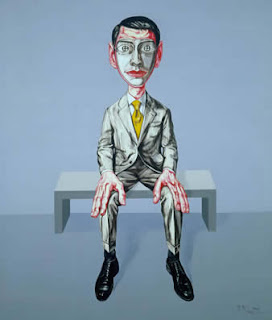Mask Series #6, arguably one of Fanzhi's most famous paintings from this series, addresses these aforementioned characteristics, reinforcing the fabrication of relationships and the reduction of individual personalities to generic facades. Grouped together, the eight characters appear as if part of a performance. Fanzhi imbues the mask's ambiguity with cheerfulness and forced intimacy to emphasize the theme of the false facade. He arranges the characters in close proximity to each other to underscoring the psychological distance between them. Fanzhi enhances this sense of isolation in Mask Series #7 by positioning a well-dressed male alone on a bench in a similarly regulated scene. With the characters' true selves hidden behind their respective masks, these individuals appear, falsely, sociable and engaging.
The vogue yellow background of Mask Series #6—other paintings from the series display bright pink, pastel blue, and light tangerine backgrounds—indicates a vague, ultimately fictitious space; its starkness rejects any ties to reality. Its saturated all-overness supports the repetition of the masks to further accentuate the psychological tension between alienation and individuality that Fanzhi offers.
The red scarf, worn around the necks of many characters, functions as a symbol of honor and noble spirit, dating back to the Chinese Cultural Revolution. Fanzhi’s choice to incorporate these neck scarves signifies an internal emotional struggle that harkens back to childhood. When in school, Fanzhi was the only student in his class denied a necktie, an emotionally scarring event that tortured him into adulthood. For Fanzhi, this iconic red scarf simultaneously represents normalcy and social acceptance while limiting uniqueness and individualism. Another distinctive feature of Fanzhi’s paintings are his character’s unusually large hands. As evident in Mask Series #6, each character’s embracing hands, disproportionately large with exaggerated veins, communicate their personal and emotional traits.[3]
Zeng Fanzhi, Mask Series No. 6, 1996
Oil on canvas
Zeng Fanzhi, Mask Series No. 7, 2000
Oil on canvas
(Un)Masked introductory text: http://artscurated.blogspot.com/2012/04/unmasked.html
[1]Li Xianting, Zeng Fanzhi, exh. cat., (Shanghai, ShanghART Gallery, 1998). http://www.shanghartgallery.com/galleryarchive/texts/id/157
[2] Karen Smith, All That Meets the Eye: Zeng Fanzhi’s Art, 1990-2002, exh. cat., (Shanghai, ShanghART Gallery, 2003). http://www.shanghartgallery.com/galleryarchive/texts/id/162
[3] Karen Smith, Mask Series 1993-1998, exh. cat. (Shanghai, ShanghART Gallery, 2006). http://www.shanghartgallery.com/galleryarchive/texts/id/155







.jpeg)

.jpeg)


No comments:
Post a Comment